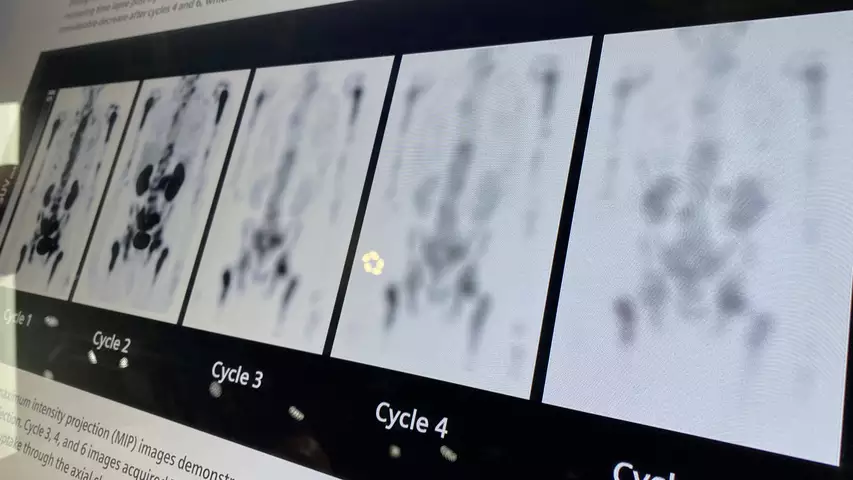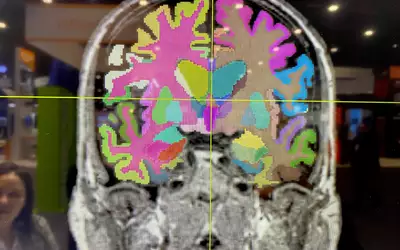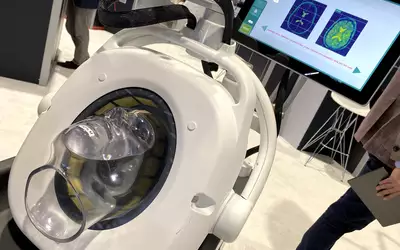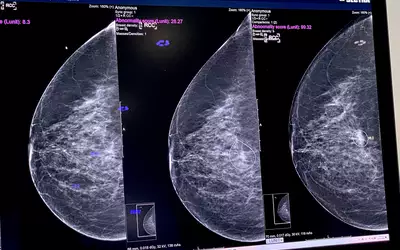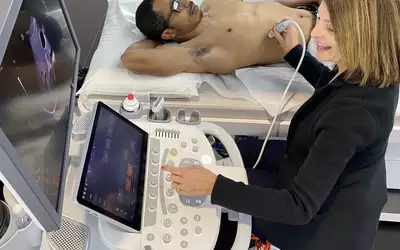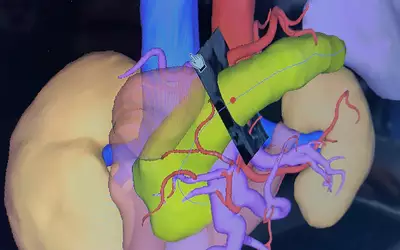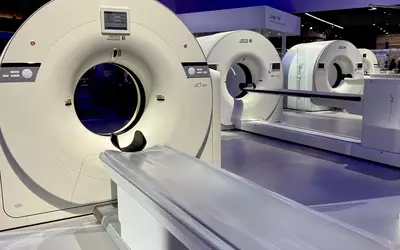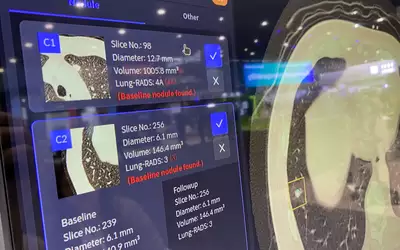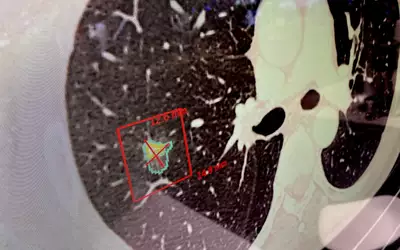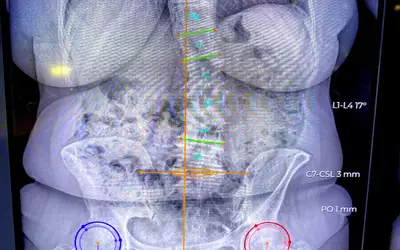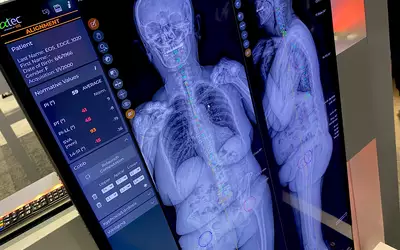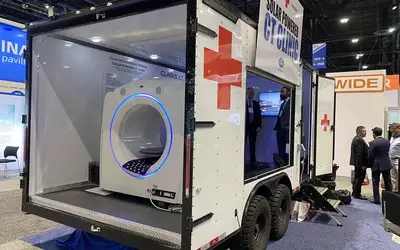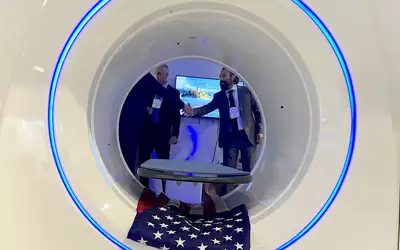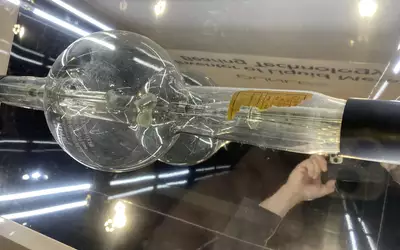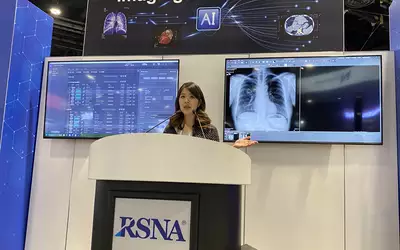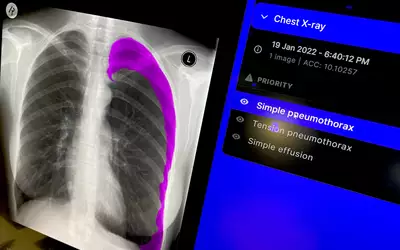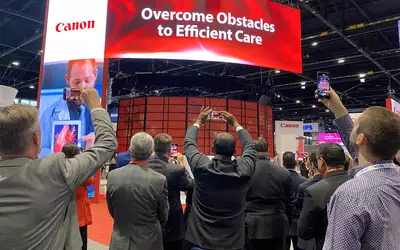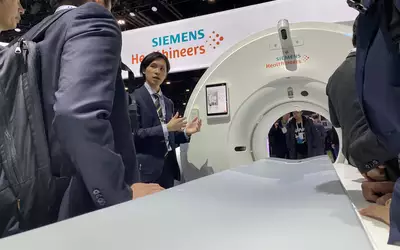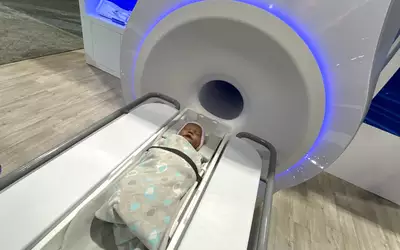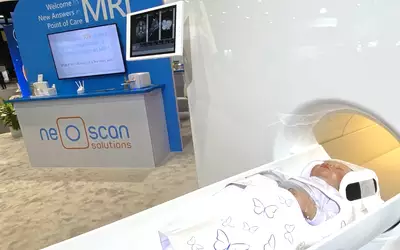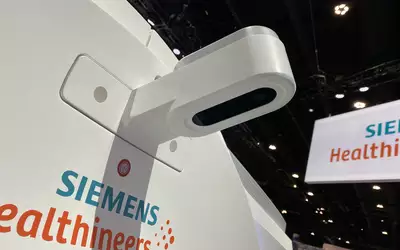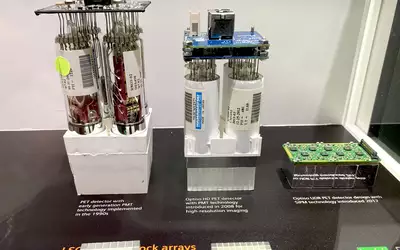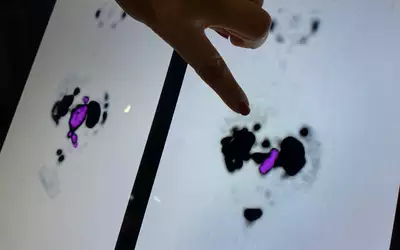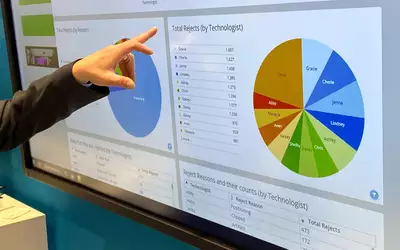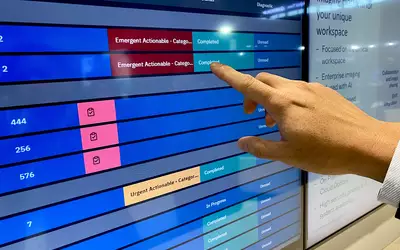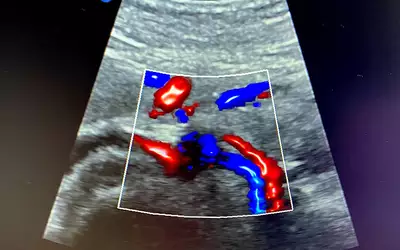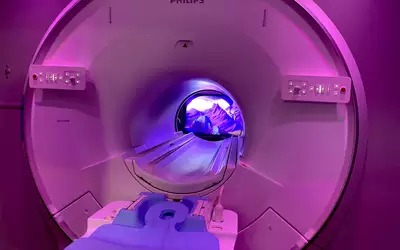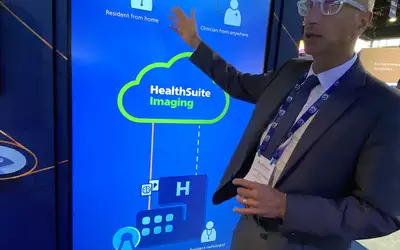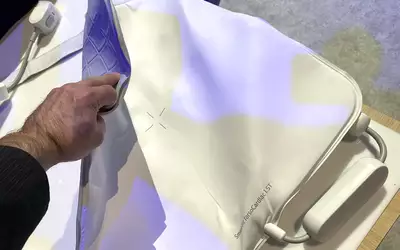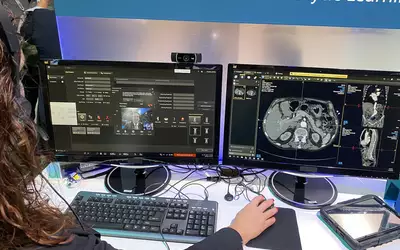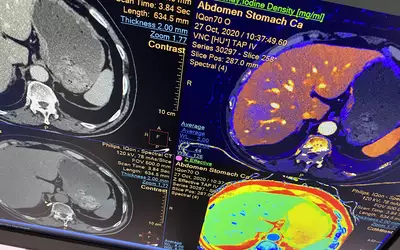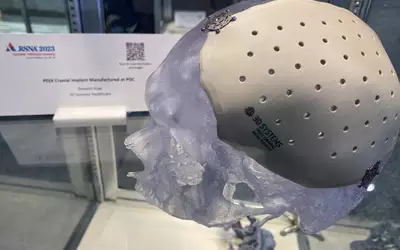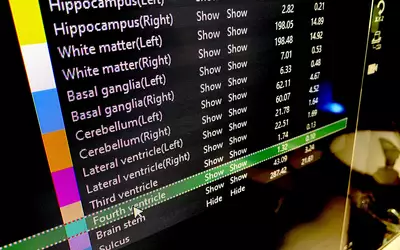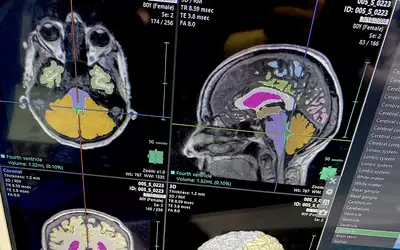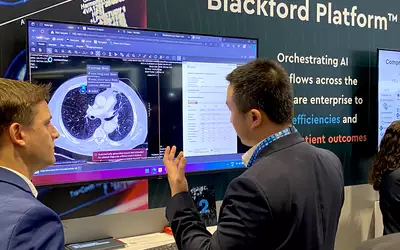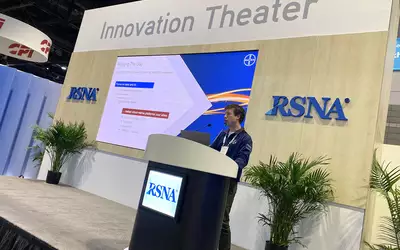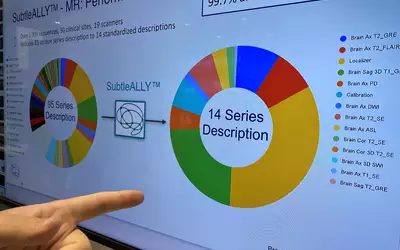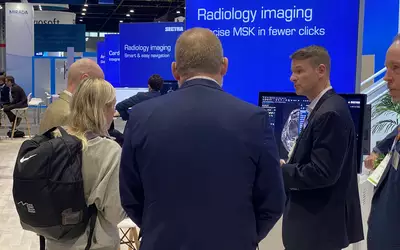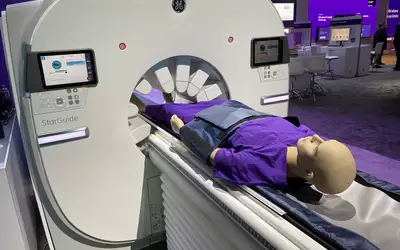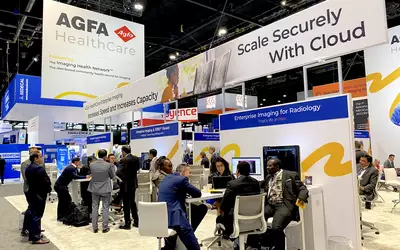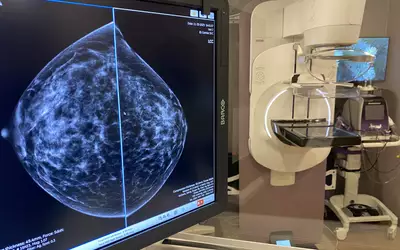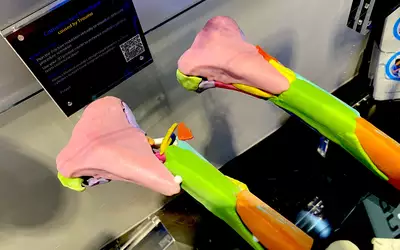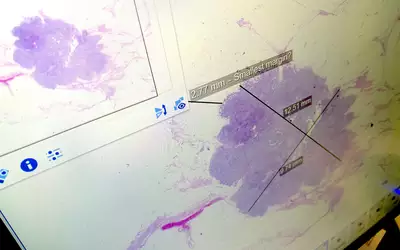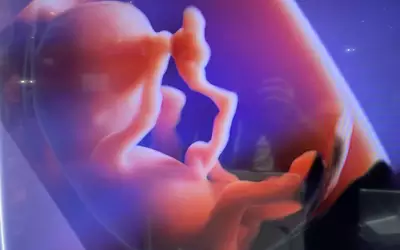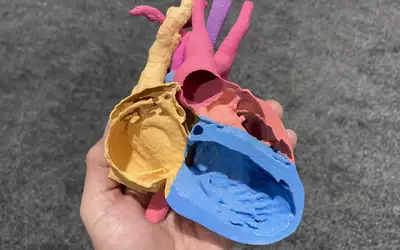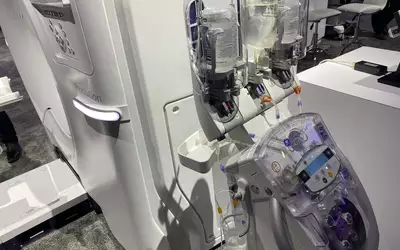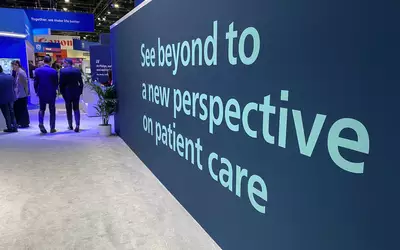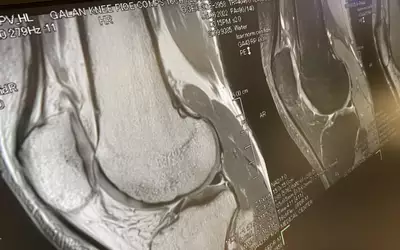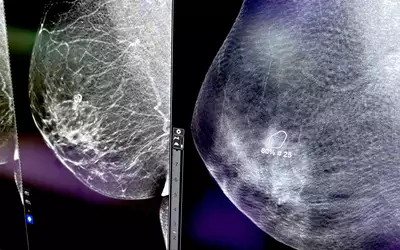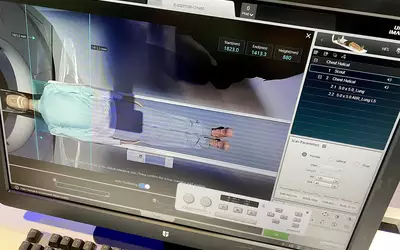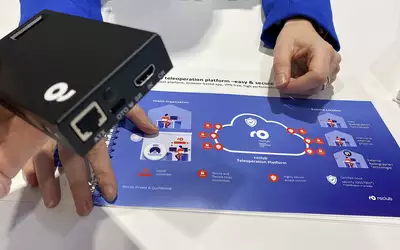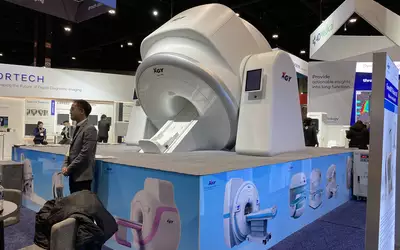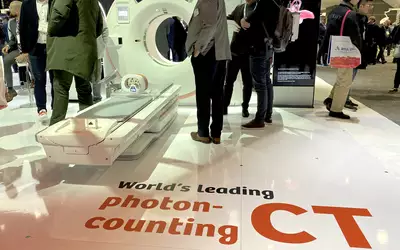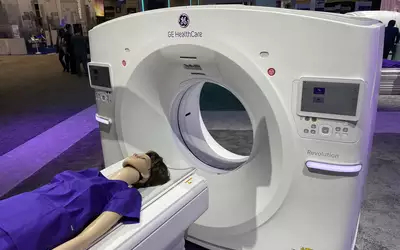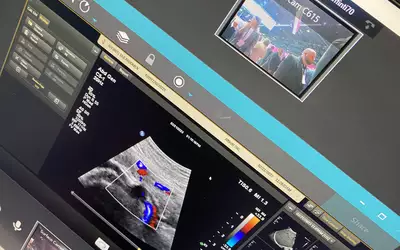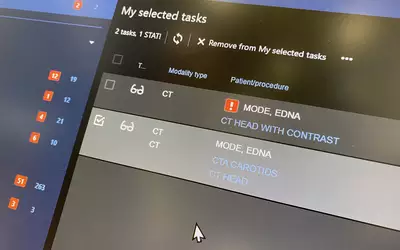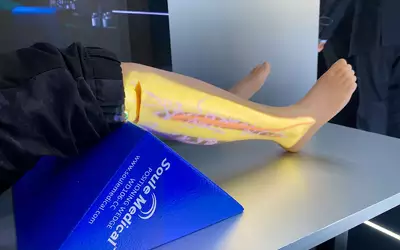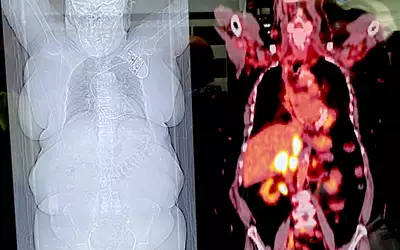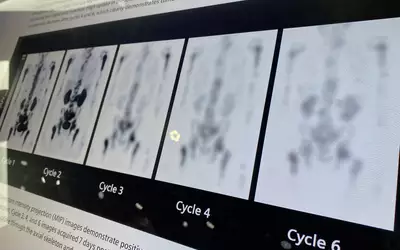PHOTO GALLERY: New technology at RSNA 2023
Images from the Radiological Society of North America (RSNA) 2023 annual meeting Nov. 26-30 in Chicago. The gallery includes new technologies and a look at views around the world's largest radiology conference. Photos include new technologies in MRI, CT, nuclear imaging, X-ray, artificial intelligence, and PACS/enterprise imaging. RSNA reported preliminary total advance registration for its 2023 meeting at 37,546. Find more news and video on our RSNA page.
Example of Vuno Med Deep Brain artificial intelligence algorithm to automate segmentation of the brain anatomy and gather more than 100 volume measurements. Tedious work like this is increasingly being assigned to AI. The accurate measurements for complex 3D shapes also can be used for more definitive diagnosis and tracking of disease or treatments over time.
A work-in-progress, point-of-care brain microwave imaging system shown by Emu EMvision at RSNA 2023. Similar to ultrasound, but uses radio-frequency waves and creates an image based on the RF signal that bounces back. It has a liquid filled rubber bladder than expands to touch the patient's head to increase the signal to noise and improve the image quality. The device is aimed at emergency departments without access to MRI or CT for stroke assessments.
Lunit's mammography AI automated lesion detection with a certainty score shown on Sectra PACS platform. Lunit is one of several AI vendors at RSNA that moved from one of the early start ups to becoming one of the larger radiology AI vendors. Often it is the OEM vendor that supplies its technology so it can be integrated into imaging systems or PACS offered by major vendors in the market.
The fleet of CT scanners on display in the United Imaging booth at RSNA 2023. The Chinese company has been attempting to break into the U.S. radiology market with a range of economy to premium systems at a lower price point. The vendor had one of the larger booths this year to show it is serious. Sections of the booth includes MRI, X-ray, MRI and artificial intelligence systems for imaging.
A demo of the new Siemens Somatom Pro Pulse dual-energy, low-cost CT system unveiled at RSNA 2023. It brings spectral CT capability to centers at the same cost of conventional workhorse CT systems. It is air-cooled, helping lower the cost of ownership. The system also is being marketed for the rising popularity of cardiac CT scanners.
Siemens introduced the first AI iso-centering camera mounted on the ceiling above the scanner at RSNA several years ago. This year, similar AI iso-centering systems were shown as new features by all the major CT vendors on the expo floor. New to Siemens is this built into the gantry AI iso-centering camera so a separate overhead installation is not needed. This is new on the just unveiled Somatom Pro Pulse CT system.
Theranostics for prostate cancer, showing regression of tumor at Siemens' booth at RSNA 2023. Theranostics uses radiotracers with radio-labeled ligands that only attach to specific types of cancer cells. This allows the nuclear imaging agents to be used for both imaging the disease, while at the same time treating the disease. This is a new technology area in cancer care that numerous vendors spoke about on the expo floor and appears to be a growing trend.
Cloud storage and cloud workflow for imaging demonstrated by Philips at RSNA 2023. Cloud is seeing a lot more traction post-pandemic since many health systems had to quickly adopt cloud in order to allow remote working. Its value is now being seen by many providers that are adopting it in various ways, usually with a mix of cloud and on premise storage. This was a trend seen across the RSNA expo floor.
Decarbonizing healthcare and radiology was discussed in RSNA 2023 sessions and by vendors looking to make their product lines more environmentally sustainable. This is a display at the entrance into the Philips Healthcare booth. The vendor announced a new partnership with Vanderbilt to find ways to reduce carbon emissions in radiology. Read more in the article How radiology departments can decarbonize, save money.
The entryway into the large RSNA AI showcase area of the expo floor. By default, RSNA is the largest conference for the clinical implementation of artificial intelligence in healthcare. AI made up by far the largest exhibitor product category at RSNA, with 242 vendors showcasing at least one such product. Medical imaging accounts for about 90% of the 740 clinical algorithms cleared so far by the U.S. Food and Drug Administration.
Nuance booth with messaging on how AI can improve workflow and radiologist efficiency. Nuance demonstrated a new AI implementation that can help automate more of the radiology report with less work by the radiologist. Solutions like this were highlighted across the expo floor because of the growing shortage of radiologists.
The radiologist staffing shortage doubled the number of health system recruiters on the RSNA 2023 expo floor. This crowd in the recruiting area is on the last day of the conference when this area is historically devoid of attendees. The radiologist shortage was the No. 1 concern vendors are seeing from customers and was prominently mentioned or discussed in sessions. Read more.
Example of a digital pathology breast specimen slides in the Sectra enterprise imaging system. Radiology and PACS administrators are often tasked with helping implement a digital pathology program because of its similarity to digital radiology. Often these systems are incorporated into wider enterprise imaging systems.
A syringeless CT contrast injector displayed by GE Healthcare. This technology uses a larger iodine contrast bolus and a series of rollers compress a circular section of tubing to inject the patient during imaging. This can help simplify workflow and reduce contrast waste. GE was also showing a similar MRI safe system that is pending FDA clearnace.
Mammography showing 2D and tomosynthesis 3D with cancer spotted by the integrated iCAD AI on a GE Pristina Bright system. GE announced a new integration partnership with iCAD at RSNSA 2023. Read more.
One of the big tech trends in CT across the expo floor was every major CT vendor showing versions of automated AI systems to isocenter patient on the bed without the need for the technologist to do anything. The AI detects the position of the patient and will move the table from side to side to ensure better imaging in the middle of the FOV in the scanner. Example shows the overhead camera view on United Imaging uCT Atlas scanner on the control room workstation.
With growing staff shortages in radiology, numerous vendors showed solutions to allow remote access to technologists and radiologists to assist remotely with CT or MRI scans. This black box from ROclub's teleoperation platform plugs into the scanner connection to the control room to enable remote access on any vendor's system.
Photon-counting CT detector technology is seen by many experts as the way of the future for computed tomography systems. There was a large number of sessions devoted to various subspeciality applications for this technology and its much higher imaging resolution and built in spectral CT capability. This is the Naeotom Alpha photon counting CT in the Siemens booth, the first commercially available system. The other major vendors are also working on their own versions of this technology.
A very short STAT reading list view generated by the Agfa AI orchestrated workflow radiology work list. The AI can present different shortened list views that are tailored to a specific radiologist's subspeciality certifications, while also load balancing a mix of exams between various readers to prevent cherry picking.
Serial imaging of a theranostic for prostate cancer, showing regression of cancers. Theranostics uses radiotracers with radio-labeled ligands that only attach to specific types of cancer cells. This allows the nuclear imaging agents to be used for both imaging and treating the disease at the same time. This is a new technology area in cancer care that numerous vendors spoke about on the expo floor and appears to be a growing trend.
Related RSNA Content:

Dave Fornell has covered healthcare for more than 17 years, with a focus in cardiology and radiology. Fornell is a 5-time winner of a Jesse H. Neal Award, the most prestigious editorial honors in the field of specialized journalism. The wins included best technical content, best use of social media and best COVID-19 coverage. Fornell was also a three-time Neal finalist for best range of work by a single author. He produces more than 100 editorial videos each year, most of them interviews with key opinion leaders in medicine. He also writes technical articles, covers key trends, conducts video hospital site visits, and is very involved with social media. E-mail: dfornell@innovatehealthcare.com































































